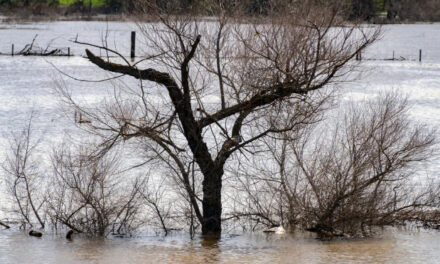DOS PALOS — It wasn’t an announcement that Darrell Fonseca wanted to make, that the city he managed no longer had running water.
That happened on June 23, 2020. The city’s five-decade-old water treatment had finally been overpowered by the algae coming from the city’s water source – the California Aqueduct, some 18 miles to the west. The algae flowing in through the city’s pipeline was simply too much, and had clogged the city’s treatment plant.
“We had a water crisis,” recalled Fonseca, who retired in March. “There were 36 hours there, over three days, when we were without water in our community. We called everybody to help us — the soft-drink companies and breweries sent water in tanker trucks to help us out.”
Most of the state and federal elected officials who represent the community of 5,800 responded, but one drove to Dos Palos to see how he could help.
“Adam Gray was one of the very few elected officials who came to our town to help us distribute water,” said Fonseca. “He had a first-hand view of what the situation was.”
Officials were able to restore service within days, but a “boil order” was in place for a short period even after service to homes was restored.
City officials knew that it was only a matter of time before the facility would be overwhelmed again. The treatment plant had been having problems for years, but now It was clear it would have to be replaced at a cost originally estimated at $11 million.
Gray took a personal interest, and began convening monthly meetings to track the issue. City, county, state and federal officials and a few non-profit representatives checked in each month. Those meetings were crucial to maintaining contact between agencies.
“When we went to the state to try to get the funding … we encountered one problem after another,” said Fonseca. “Cross this ‘t,’ dot that ‘I’ … it had gone on like that for years.”
By taking on the role of convening the meetings and monitoring developments, Gray was making the Dos Palos water treatment problem his to solve. And that’s what happened.
“It was his direct involvement that kept the state focused on delivering funding to our community,” said Fonseca.
Unfortunately, it eventually became clear that the original estimate of $11 million would be inadequate to the task. That presented “the last hurdle,” said Fonseca.
“We decided we needed to go back to the state and try to get an upgrade,” said Fonseca. “We were seeking $23 million, but they came back to us and said ‘No, we’re going to give you $30 million.’
“We looked at each other and said, ‘How is that possible?’ … We all believe to this day that what put us over that last hurdle was Adam Gray. … He stepped up and said, ‘Look, we have to get this done.’ His influence at the state did it. Every time we encountered someone at the state, they said, “Adam Gray, Adam Gray. Oh, this is for Adam Gray.’
“It was his personal commitment to our community that enabled us to get over the finish line.”
Gray deflected the praise. “When something like this happens in our rural communities, it’s like no one notices,” said Gray. “Too many people say, ‘It’s only 5,800 people, we’ve got bigger problems.’ Well, to those 5,800 people – my neighbors, my constituents – not having drinking water is the biggest problem in their lives at that moment. That’s why the state has to help solve it.
“I’m glad I was able to help and I’m glad the state stepped in and stepped up.”
Repairs were made to get water flowing, but construction on the new treatment facility is expected to begin within the next few months. “Adam Gray gets it,” said Fonseca. “Adam is out there, he does it, he knows it and when he comes to town he knows us all by name.”



